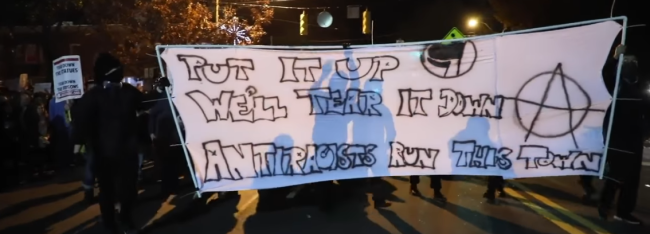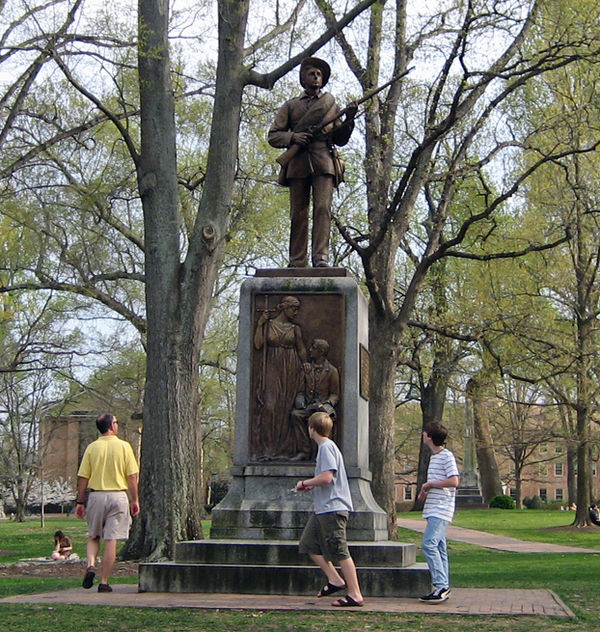You have /5 articles left.
Sign up for a free account or log in.

Protest against returning Silent Sam to campus
YouTube
The University of North Carolina at Chapel Hill's board and chancellor on Monday unveiled a plan to return Silent Sam, a statue of a Confederate soldier, to campus. The statue would be housed in a new building that would cost more than $5 million to construct and $800,000 a year to maintain.
By returning the statue to campus, officials hope to comply with a state law limiting the movement of memorials. By locating the statue in a building, with security, the university hopes to avoid additional efforts to destroy or take down the monument. Officials have also said that the building's location, less prominent than the spot where the statue had been before, would lessen the offense many feel at honoring the Confederacy.
Chapel Hill officials said that they would prefer to see the statue relocated off campus, but that they are submitting a plan that complies with state law to return the statue to campus. The university also plans to "contextualize" its history, which includes slavery, Jim Crow and the civil rights movement.
"Our community and nation have struggled for a long time with deeply rooted issues of race, inclusion, opportunity, pride and memory associated with America’s history. These driving societal and historical forces will be essential to creating a truthful and full historical contextualization both of our university and the Confederate monument," said an email to the campus from Carol L. Folt, the chancellor, and Robert A. Blouin, executive vice chancellor and provost.
The UNC system's Board of Governors still must approve the plan. Even if the board approves the plan, the controversy is not likely to end.
Erika K. Wilson, the Thomas Willis Lambeth Distinguished Professor in Public Policy at Chapel Hill, wrote on Twitter, "@UNC’s recommendation to not re-erect #SilentSam on campus & to spend $5.3 million on a building to house it & $800,000 annually on operating costs is a slap in the face to the many black students, faculty & staff who oppose this symbol of white supremacy."
Protests were quickly organized and took place Monday evening, with students and others blasting the decision -- regardless of state law -- to return Silent Sam to campus. A statement issued by one group organizing a rally said that "the UNC community has consistently and forcefully made clear that to reinstall the Confederate monument to any location on UNC's campus is to herald for the nation and for the world that UNC is not a welcoming place for black people." The new building for the statue will be "a safe space for white supremacy and forcing us to pay for it," the statement added.
Hundreds of students marched in Chapel Hill, with some calling for a strike by professors to insist that the statue not return to campus. "It seems UNC is more willing to spend money on a racist relic of the past than students who attend this school," an editorial in The Daily Tar Heel said. "Once again, the administration has made it clear that minority students are merely props, to be used and exploited when it is convenient for them."
The editorial said that many projects that would help students -- and in particular minority students -- could benefit from the money the university will spend to house the statue.
Monday's decision was the official response of the university to the topping of Silent Sam by protesters in August. Protesters used ropes to take down the statue, which was then removed by the university, setting off a debate on whether and how it would return to campus.
The action came after years of debate. As many other colleges and universities removed Confederate statues and symbols, UNC officials said that they lacked the power to remove the statue, with the campus deferring to the system, and the system board in July saying that any decision needed to come from a state agency and that the system had no plans to ask that agency to act.
Student and faculty activists have been asking for Silent Sam to be taken down for years, but the violence last year in Charlottesville, Va., gave the effort a new sense of urgency. Governor Roy Cooper said UNC could remove the statue, but the university said it did not have “clear legal authority to act unilaterally.” Meanwhile, protests continued until the August night when the statue was pulled down. (The governor is a Democrat, but system board members are appointed by the General Assembly, which is controlled by Republicans.)
 Silent Sam, representing all Confederate soldiers, was put up by alumni and the United Daughters of the Confederacy in 1913 to honor alumni who fought for the Confederacy in the Civil War. The photo at right shows the statue as it appeared on campus.
Silent Sam, representing all Confederate soldiers, was put up by alumni and the United Daughters of the Confederacy in 1913 to honor alumni who fought for the Confederacy in the Civil War. The photo at right shows the statue as it appeared on campus.
On some campuses, such as the University of Texas at Austin and Duke University, statues of Confederates have been vandalized (and then cleaned) in the debates leading up to the universities' decisions to remove the statues. But in those cases, protesters did not take down the statues.
Some Republican politicians in North Carolina have been pushing the university to return the statue to its former location or someplace else prominent on campus. Many student and faculty groups, meanwhile, have said that the statue should not return to campus.
Historians have noted that it was put up as part of a campaign in North Carolina to promote white supremacy.
In September, the university said that the statue would return to campus, but that the location remained to be determined. Initially, the plan was to have a proposal for the university system's Board of Governors prepared by November, but an extension was granted, setting the stage for today's announcement.
The September announcement led to many statements calling for the statue to never be returned to the campus.
A statement from black faculty members at UNC, published in The Daily Tar Heel, said in part, "A monument to white supremacy, steeped in a history of violence against black people, and that continues to attract white supremacists, creates a racially hostile work environment and diminishes the university’s reputation worldwide. For us, arguments of moral equivalency are extremely problematic; there are not two morally valid sides to the history the monument represents nor to its current significance … To reinstall the Confederate monument to any location on UNC’s campus is to herald for the nation and for the world that UNC is not a welcoming place for black people."








